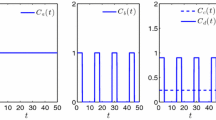Abstract
A competition model describing tumor-normal cell interaction with the added effects of periodically pulsed chemotherapy is discussed. The model describes parameter conditions needed to prevent relapse following attempts to remove the tumor or tumor metastasis. The effects of resistant tumor subpopulations are also investigated and recurrence prevention strategies are explored.
Similar content being viewed by others
References
Agur, Z., R. Arnon and B. Schechter. 1988. Reduction of cytotoxicity to normal tissues by new regimens of cell-cycle phase-specific drugs.Math. Biosci. 92, 1–15.
Aroesty, J., T. Lincoln, N. Shapiro and G. Boccia. 1973. Tumor growth and chemotherapy: Mathematical methods, computer simulations, and experimental foundations.Math. Biosci. 17, 243–300.
Bellomo, N. and G. Forni. 1994. Dynamics of tumor interaction with the host immune system.Math. Comput. Modelling 20, 107–122.
Berenbaum, M. C. 1969. Dose-response curves for agents that impair cell reproductive integrity.Br. J. Cancer 23, 434–445.
Birkhead, B. G. and W. M. Gregory, 1984. A mathematical model of the effects of drug resistance in cancer chemotherapy.Math. Biosci. 72, 59–69.
Burger, R. A., E. A. Grosen, G. R. Ioli, M. E. Van Eden, H. D. Brightbill, M. Gatanaga, P. J. DiSaia, G. A. Granger and T. Gatanaga. 1994. Host-tumor interaction in ovarian cancer spontaneous release of tumor necrosis factor and interleukin-1 inhibitors by purified cell populations from human ovarian carcinoma in vitro.Gynecologic Oncology 55, 294–303.
Cojocaru, L. and Z. Agur. 1992. A theoretical analysis of interval drug dosing for cell-cycle-phase-specific drugs.Math. Biosci. 109, 85–97.
Cornil, I., D. Theodorescu, S. Man, M. Herlyn, J. Jambrosic and R. S. Kerbel. 1991. Fibroblast cell interactions with human melanoma cells affect tumor cell growth as a function of tumor progression.Proc. Natl. Acad. Sci. USA 88, 6028–6032.
Dotto, G. P., A. Weinberg and A. Ariza. 1988. Malignant transformation of mouse primary keratinocytes by Harvey sarcoma virus and its modulation by surrounding normal cells.Proc. Natl. Acad. Sci. USA 85, 6389–6393.
Eisen, M. 1979.Mathematical Models in Cell Biology and Cancer Chemotherapy. Lecture Notes in Biomathematics, Vol. 30. New York: Springer-Verlag.
Fisher, B. and E. R. Fisher. 1959. Experimental studies of factors influencing hepatic matastases.Cancer 12, 929–932.
Gatenby, R. A. 1991. Population ecology issues in tumor growth.Cancer Res. 51, 2542–2547.
Gatenby, R. A. 1994. Population ecology models of neoplastic growth: Implications for tumor biology and treatment. Private communication with Dr. John Adam.
Goldie, J. H. and A. J. Coldman. 1979. A mathematical model for relating the drug sensitivity of tumors to their spontaneous mutation rate.Cancer Treat. Rep. 63, 1727–1733.
Gyori, I., S. Michelson and J. Leith. 1988. Time-dependent subpopulation induction in heterogeneous tumors.Bull. Math. Biol. 50, 681–696.
Jansson, B. and L. Révész. 1977. Cell ecology: Deductive and dynamic models for proliferation, differentiation and competition of tumor cell populations.J. Theoret. Biol. 68, 43–51.
Knolle, H. 1988.Cell Kinetic Modelling and the Chemotherapy of Cancer. Lecture Notes in Biomathematics, Vol. 75. New York: Springer-Verlag.
Kot, M. and E. Funasaki. 1993. Invasion and chaos in a periodically pulsed mass-action chemostat.Theoret. Population Biol. 44, 203–224, 1992.
La Rocca, S. A., M. Grossi, G. Falcone, S. Alemà and F. Tatò. 1989. Interaction with normal cells suppresses the transformed phenotype of v-myc-transformed quail muscle cells.Cell 58, 123–131.
Leith, J. T., G. Padfield and S. Michelson. 1992. Effects of partial hepatectomy on the growth characteristics and hypoxic fractions of xenografted DLD-2 human colon cancers.Rad. Res. 132, 263–268.
Liotta, A. L. 1992. Cancer cell invasion and metastasis.Scientific American February, 54–63.
Martin, R. B., M. E. Fisher, R. F. Michin and K. L. Teo. 1992a. Low-intensity combination chemotherapy maximizes host survival time for tumors containing drug-resistant cells.Math. Biosci. 110, 221–252.
Martin, R. B., M. E. Fisher, R. F. Michin and K. L. Teo. 1992b. Optimal control of tumor size used to maximize survival time when cells are resistant to chemotherapy.Math. Biosci. 110, 201–219.
Michelson, S. and J. T. Leith. 1988. Unexpected equilibria resulting from differing growth rates of subpopulations within heterogeneous tumors.Math. Biosci. 91, 119–129.
Michelson, S. and J. T. Leith. 1991. Autocrine and paracrine growth factors in tumor growth: A mathematical model.Bull. Math. Biol. 53, 639–656.
Michelson, S. and J. T. Leith. 1993a. Growth factors and growth control of heterogeneous cell populations.Bull. Math. Biol. 55, 993–1011.
Michelson, S. and J. T. Leith. 1993b. Tumor heterogeneity: A review of the theory.Drug News & Perspectives 6, 655–661.
Michelson, S. and J. T. Leith. 1995. Interlocking triads of growth control in tumors.Bull. Math. Biol. 57, 345–366.
Michelson, S., B. E. Miller, A. S. Glicksman and J. T. Leith. 1987. Tumor micro-ecology and competitive interactions.J. Theoret. Biol. 128, 233–246.
Miller, F. R., D. Medina and G. H. Heppner. 1981. Preferential growth of mammary tumors in intact mammary fatpads.Cancer Res. 41, 3863–3867.
Murray, J. M. 1990. Some optimal control problems in cancer chemotherapy with a toxicity limit.Math. Biosci. 100, 49–67.
Panetta, J. C. and J. A. Adam. 1995. A mathematical model of chemotherapy: Cycle-specific therapy.Math. Comput. Modelling.22 (2), 67–82.
Paschkis, K. E., A. Cantarow, J. Stasney and J. H. Hobbs. 1955. Tumor growth in partially hepatectomized rats.Cancer Res. 15, 579–582.
Swan, G. W. 1981.Optimization of Human Cancer Radiotherapy. Lecture Notes in Biomathematics, Vol. 42. New York: Springer-Verlag.
Waltman, P. 1983.Competition Models in Population Biology, Vol. 45. Society for Industrial and Applied Mathematics, Philadelphia, PA.
Webb, F. G. 1992a. A cell population model of periodic chemotherapy treatment.Biomedical Modeling and Simulation, pp. 83–92. New York: Elsevier Science Publishers.
Webb, G. F. 1992b. A nonlinear cell population model of periodic chemotherapy treatment.Recent Trends in Ordinary Differential Equations. Series in Applicable analysis, Vol. 1, pp. 569–583. Singapore: World Scientific Publishing Company.
Author information
Authors and Affiliations
Rights and permissions
About this article
Cite this article
Panetta, J.C. A mathematical model of periodically pulsed chemotherapy: Tumor recurrence and metastasis in a competitive environment. Bltn Mathcal Biology 58, 425–447 (1996). https://doi.org/10.1007/BF02460591
Received:
Issue Date:
DOI: https://doi.org/10.1007/BF02460591




